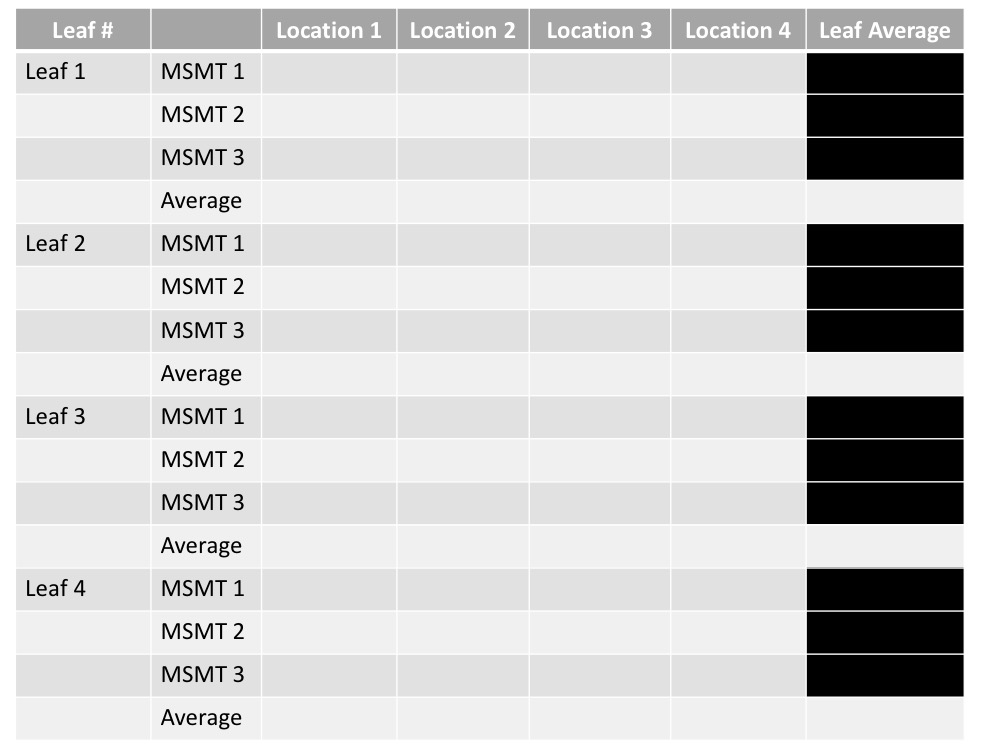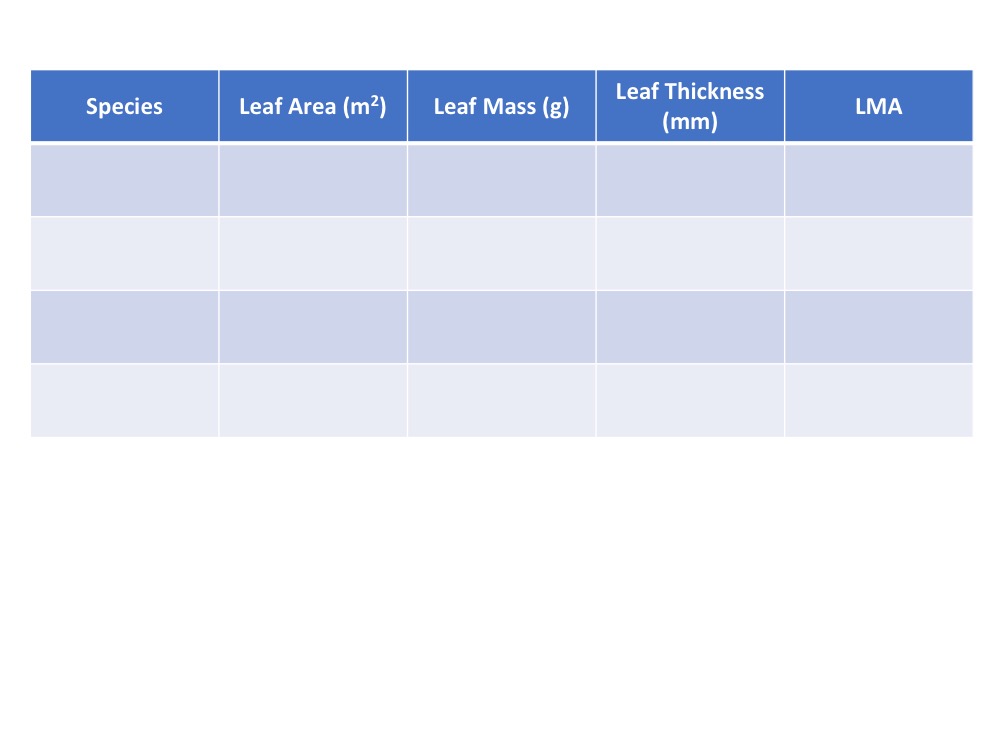F/RS 310
Assignment #4
Leaf Mass Area (LMA)
45 Points Possible
Background
In order to manage the natural resources of our terrestrial surface, we need to understand as much as possible about how plants will respond to changes in their environmental conditions. Unfortunately, there are ~ 391,000 vascular plants species growing on earth, and it would be very difficult to measure the response of each species to every possible environmental change they might experience. Instead, plant scientists are looking for ways to measure one or two simple traits to estimate how plants will respond to a host of changes. One of the most commonly measured leaf trait is Leaf Mass Area (LMA). LMA is simply the mass of a leaf divided by its area; which provides an estimate of the investment plants make into their leaves (mass) relative to the area use to capture sunlight (area). Plants that invest more in producing their leaves (larger LMA values) generally hold on to their leaves for longer, and utilize a more conservative growth strategy (ie. slow and steady).
Objective
The objective of this lab activity is to help you develop a deeper understanding of what LMA is and its ecological implications. In order to accomplish this, you will have the opportunity to measure LMA and compare the values between different plants from different functional groups.
Student Learning Outcomes
After you have completed this assignment you should be able to:
- Define LMA
- Explain the growth strategies of plants with varying LMA
- Measure the components of LMA and be able to describe potential sources of error
- Perform a literature search
- Outline a lab report
Description of Lab Activities
This lab activity will take place over two weeks.
Week 1
- Harvest one leaf from each of 4 different species in the arboretum and bring them with you to lab. Try to get leaves from 2 conifers and 2 broadleaf trees if possible – that way we can compare these two functional groups. We will begin our lab 20 minutes later than normal so you can get your leaves immediately prior to lab if you want.
- Measure LMA
- Measure leaf area
- Place all 4 leaves on the scanner at the same time (assuming they all fit) ensuring that they are laying as flat as possible (you can use scotch tape to help encourage leaves to lay flat)
- Scan your leaf on the following settings
o Mode: Professional
o Document Type: Reflective
o Auto Exposure Type: Photo
o Image Type: Black & White
o Resolution: 600 dpi - Analyze each leaf to calculate area
- Click on the ImageJ icon to activate this application
- Open your scanned image in ImageJ
- Select a single leaf on your image using either the rectangle select, circle select, or lasso tool.
o Go to >Analyze>Analyze Particles
o Make sure the ‘Size’ box says “0.1-Infinity”
o Click on ‘OK’
o You will get two windows – use the ‘area’ data from the ‘Summary’ window. - Repeat for your other 3 leaves.
- Measure Leaf thickness
- Get a pair of calipers
- You will measure the thickness of the leaf lamina at 4 different locations and 3 replicates at each location
- Note: Make sure that you don’t ‘squeeze’ the calipers closed or else you’ll be pinching leaf, but press firmly enough to close the calipers ‘snugly’ onto the leaf surface. It helps if you don’t use just the tips of the calipers, but place the leaf further into the ‘mouth’ of the calipers.
- Calculate the average of the three measurements at each location
- Calculate the average of the four locations to estimate leaf lamina thickness of each leaf.
- Measure leaf area

- Dry Leaves to prepare them to measure leaf dry mass
- Place each leaf in a coin envelope
- Label envelope with the following information
- Lab Meeting Time
- Group Name
- Species
- Give coin envelopes to your instructor – they will dry your leaves and return them to you next week to weight
- Fill out the table below for your final results

Literature Search
- Carry out a literature search to find photosynthetic rate and leaf longevity data for each species.
- You must find 3 citations per species and then take the average value – so you’ll probably want to divide up the species among your group members to spread out the workload.
- Google Scholar is a good source for searching for relevant literature, but feel free to use any search engine you like.
- Once you find an article, make sure to save a pdf version of the article so you can reference it later for your report
- Helpful search terms, if you include one or two of the terms below with your species name, you should find some articles that report this data.
1. photosynthesis
2. photosynthetic rate
3. gas-exchange
4. maximum photosynthetic rate
5. leaf longevity
6. leaf lifespan
Week 2
- Do some initial data analysis and make some hand-drawn figures
- Compare the average of your conifer species to your broadleaf trees. After calculating the mean values of LMA, you might want to consider displaying it as a barplot
- Make two scatter plots with LMA as your independent axis
- Plot 1 – use photosynthesis as your dependent axis
- Plot 2 – use leaf longevity as your dependent
- After you have made these plots, find one other group and compare your data to theirs. Make sure to note any agreements or disagreements in your data and include these comparisons in your discussion section.
- As you look at your data, work with your lab partner to answer the following questions. Your instructor will come around and discuss these questions with you.
- Do the absolute values you calculated agree with theirs (are they in the same general values?)
- Do the patterns you found agree with theirs?
- Do your conifers differ from broadleaf trees, and in the same direction?
- Are there relationships between LMA and either photosynthesis or leaf longevity?
Description of Assignment
You must provide the outline for a scientific paper as your report for this assignment, you will include the same sections that would occur in most scientific papers, but you just need to provide ‘bullet point’ statements for this assignment. We will work on developing a full report in subsequent lab assignments. Below is what should be included in each section.
Introduction
Your discussion should include as least 4 bullet points
- Define LMA
- Describe what causes differences in LMA among species
- State 2 hypotheses about the relationship of LMA to photosynthesis and leaf longevity
Materials and Methods
In this section describe everything you did to get the data you will present. Instead of bullets, in this section you should create several numbered lists that describe the steps you used to make each measurement. Be as specific as possible including how many measurements you made and many articles you got data from and the search terms you used to find the articles. The lists you create should describe:
- Species you selected and the harvesting of leaves
- Measuring leaf area
- Measuring leaf thickness
- Drying and weighing leaves
- Calculating LMA
- Getting data from the literature
Results
- Include, at least, two figures displaying your results
- Write a short legend to go along with each figure
- Include 1-2 bullet points of the main results of each figure
- Discussion
- In this section a typical discussion section you would describe any new findings in detail and provide evidence from the literature defending your conclusions. You would also discuss the importance of your new findings, as well as any uncertainties about your project. For this assignment you should include the following bullet points:
- Did your results agree with hypotheses? Why/Why Not?
- A brief statement about the implication of the results in figure 1
- A brief statement about the implication of the results in figure 2
- Identify largest source of uncertainty in your results